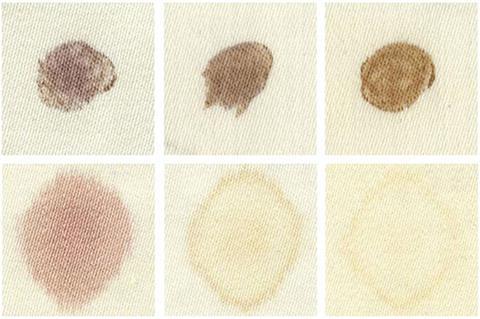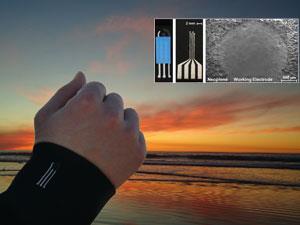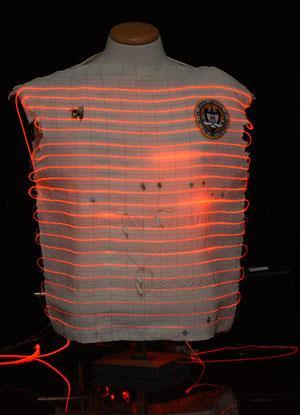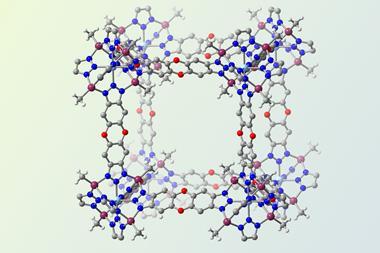The clothing of the future may be able to do much more than preserve one’s dignity. Nina Notman reports on what you can expect from the 21st century t-shirt
The clothing of the future may be able to do much more than preserve one’s dignity. Nina Notman reports on what you can expect from the 21st century t-shirt
Clothing’s most important role is to help our bodies maintain a comfortable temperature. Secondary to that is a desire to cover certain body parts from others’ eyes, and of course to help us look and feel attractive. But in the future our clothing could achieve so much more: from staying clean to purifying the air, sensing explosives and monitoring our health. In the coming years our textile industry looks set to get seriously high tech. Chemistry World takes a look at some of the avenues that researchers into smart clothing are exploring.
Clothes, clean thyself
Why not give your washing machine a break? Fabrics that can clean themselves without the use of water – known as self cleaning - are coming to fruition. ‘They are the same as any other material in that they get dirty, but they have the ability to clean themselves,’ explains Walid Daoud, a self cleaning expert at Monash University in Australia. The fabrics he works on need just light to activate the cleaning process, so clothes made from this material could be taken off when dirty and simply hung on the line outside for cleaning to occur. This would bypass the time-consuming, expensive and environmentally unfriendly machine-washing .

‘The way it works is that we apply a very thin layer of coating on the surface of the fibres, and that layer contains a [titanium dioxide] catalyst that is activated by light,’ says Daoud. ‘Once light falls on it, it generates oxidants and these oxidants then attack any surface-attached dirt or stains and therefore they get degraded. Dirt is broken down eventually into carbon dioxide and water.’
Working out how to maintain the original properties of the fabric has been a major hurdle for these materials over recent years. ‘You need to make sure the coating does not introduce any adverse effects on the intrinsic properties of the original textile materials. For example the hydrophilicity, the breathability, the comfort, the handling and feel, the mechanical properties and the elasticity of the material [should all remain the same],’ Daoud says. ‘So what is special about the coating we have is that the photocatalyst is a very small size and that does not adversely affect any of the properties associated with the original material. The size of the particles contained in the coating are around 4-6nm. And also the thickness of the coating does not exceed 100nm.’
Another key property of Daoud’s coating is that its application can be easy integrated into the standard textile manufacturing process, keeping costs down. ‘We use a very conventional method that has been used for textiles for centuries, known as dip, pad, dry, cure,’ says Daoud. ‘The first step is to dip the material in a formulation that contains the catalyst, second is to pad it – in order to squeeze out the excess liquid – and then dry. You have to dry until the coating becomes solid. And then you have to cure it - a fixation process whereby the coating then sticks to the fibres.’ So far, Daoud has shown his coating works well on cotton1 and wool2.
Asked about commercialisation Daoud says ‘we have interest from various textiles manufacturers’. So with luck this coating – or other similar ones being researched worldwide – may make it to market soon.
Clearing the air

Ryan, based at the University of Sheffield, explains how it works: ‘The titanium dioxide particle absorbs photons, mainly in the ultraviolet, that excite an electron. The excited electron reacts with oxygen to make singlet oxygen. Singlet oxygen reacts with the water [in air] to make peroxy radicals. Peroxy radicals react with everything. They transform nitric oxide into nitric acid which then makes a water soluble nitrate salt. Or if it’s a volatile organic, they oxidise the volatile organic to make something that is more oxygenated and then water soluble.’ The salts and other water soluble products will then be removed in the washing machine.
For this concept to have a real impact on air pollution large numbers of people need to join in. ‘Because of the nature of the technology, the more people that use it, the more each individual benefits,’ says Ryan. ‘A pair of jeans will take out about 2g of nitric oxide a day and so if there is only 1000 people in the city wearing catalytic clothing then no one will really notice an effect. For example, in Sheffield, you’d need half the people to have catalytic jeans on to cause a 20% reduction in the nitric oxide level over the year.’
And to make this a possibility, instead of marketing clothing with the coating already applied, the idea is to sell the product as a laundry additive that everyone can add to their washing machine during a standard washing cycle. The catalytic particles would stick to the clothing during the washing cycle because they are electrostatically charged. ‘There is a charge stabilisation in the salt and that charge stabilisation means that they stick to cotton,’ explains Ryan. And it isn’t just cotton-specific: ‘it just happens to be better on cotton because of the electrostatics’. The duo is current working with Ecover and other personal care companies towards marketing this product. And Ryan is hopeful that the costs to the consumer will be very low. ‘There is currently 10p of titania on a pair of jeans.’
Clothing with this coating maintains all the intrinsic properties of the original material, and Ryan himself always wears catalyst-coated jeans. These, and other garments used in a number of high profile displays of this concept, have been treated by spraying the coating on after the clothing has been manufactured. This spray-on technology is ready to market right now, but due to the large number of participants Ryan is hoping will sign up to this idea, he is currently pursuing the laundry additive route. ‘We’d prefer not to do branded clothing, we’d much rather do a completely democratic retrofit.’
Sensing trouble
Coining the term lab-on-a-textile, US chemist Joe Wang is looking at using clothing for a different purpose: sensing. His technology, based on fabric-printable chemical sensors, has been demonstrated on a variety of different textile fabrics and for analytes ranging from hydrogen peroxide in sweat to explosives in the environment.
The sensors are comprised of an array of carbon electrodes screen-printed onto fabric. ‘The technology is like that used in glucose strips for diabetics,’ explains Wang, who is based at the University of California in San Diego. ‘It is electrochemical detection.’
The first of his projects involved sensors printed into the waistband of men’s briefs.4 Direct exposure to the skin meant the team were able to detect hydrogen peroxide and the enzyme NADH in sweat, chemicals that are associated with a number of biological processes. The main goal of this work is to use the sensors to monitor the health of the wearer. ‘However, we also want to extend the scope to other applications,’ says Wang. ‘Particularly attractive will be dehydrogenase- and oxidase-based enzyme sensors for ethanol and lactate, respectively, in connection with monitoring alcohol consumption in drivers or performance of soldiers and athletes.’
Wang’s team have worked extensively to ensure the durability of the sensor technology, and this effort is still ongoing. ‘We have already demonstrated that it can survive washing, it can survive bending and stretching and so on.’ Future work on this brief project will also include looking at ways to integrate supporting devices such as display and communication. At present, the sensor requires external devices for its output to be read.
Wang is also keen to use his concept in sensing hazardous analytes in the air, such as explosives. He has shown that electrochemical sensors printed on Gore-Tex can detect vapour from the explosives DNT (2,4-dinitrotoluene) and TNT (2,4,6-trinitrotoluene).5 He says that hands-free sensors built into clothing will offer the wearer – such as a soldier or firefighter – unrestricted movement, without the need to wear an extra device.

Wang says there is a lot in interest in commercialisation, giving the example of a major international sportswear manufacturer that is looking at putting the technology into trainers.
E-textiles
While Wang’s sensors are the first examples of wearable chemical sensors, wearable physical sensors have been in development for some time. One example is the ‘smart shirt’ or wearable motherboard developed by Sundaresan Jayaraman at the Georgia Institute of Technology in Atlanta, US.7 ‘Every computer or mobile phone has got a motherboard with multiple chips. The whole concept here is how do I create a structure which is flexible, that is wearable, that is washable, into which I can plug in a whole bunch of sensors,’ Jayaraman explains. Off-the-shelf sensors that can be plugged into the shirt include heart-rate monitors and temperature probes.
The ability to plug in a variety of different sensors means that the applications for this shirt are far-reaching. ‘The applications range all the way from little babies to senior citizens,’ says Jayaraman. Examples he gives include monitoring babies that might be prone to sudden infant death syndrome, performance during athletic training and heart function after bypass surgery. And it is not only sensors that are plugged into the motherboard, but also a battery pack and wireless communications – to send the sensor’s output where required. Making the system autonomous, unlike Wang’s.
The shirt is made from conducting fibres that have been woven into the textiles structure on a typical weaving machine. ‘What we do is interdisperse these conductive fibres between the regular fibres,’ Jayaraman says. ‘Depending on the density of the conductive materials we need, we can change the composition.’
The conducting fibres are comprised of either stainless steel or silver coated nylon. ‘The beauty of it is that the fibres are so thin that they are very, very flexible,’ says Jayaraman. ‘They can be woven into any find of material: for instance, we have knitted them in with cotton, with polyester, and with a blend of cotton and polyester. Really, the infrastructure material really does not matter, because the flexibility, the elasticity and the material characteristics are similar to what you would have in a typical textile fibre.’

The US army funded the optical fibres version of the shirt, and Jayaraman has not been kept informed in the progress regarding development for us in battle situations. Meanwhile, he is looking towards commercialising the standard smart shirt, but declined to provide any further information.
With a revolution soon to take place in the textiles industry, now is the time to bet your shirt and take your hat off to all those involved.
Nina Notman is a science writer based in Salisbury, UK
References
1 W A Daoud and J H Xin, J. Am. Ceram. Soc., 2004, 87, 953 (DOI: 10.1111/j.1551-2916.2004.00953.x)
2 W A Daoud et al, Chem. Mater., 2008, 20, 1242 (DOI: 10.1021/cm702661k)
4 Y-L Yang, Analyst, 2010, 135, 1230 (DOI: 10.1039/b926339j)
5 M-C Chuang, Electroanalysis, 2010, 22, 2511 (DOI: 10.1002/elan.201000434)
6 K Malzahn, Analyst, 2011, 136, 2912 (DOI: 10.1039/c1an15193b)












No comments yet